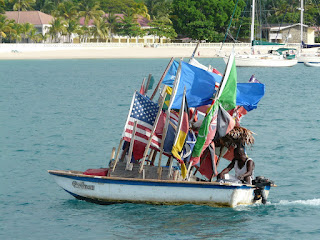We arrived early afternoon on Saturday 6 June and anchored in Rodney Bay, a bay on the North-West corner of the island. Rodney Bay is over a mile long and consists of a beautiful white sandy beach lined with upmarket tourist resorts and the St Lucia Yacht Club. Rodney Bay Lagoon which is accessible from Rodney Bay is a large and completely protected inner lagoon containing a recently renovated marina with slips that now cater for large white boats. The marina village services the yacht community well with Customs and Immigration being located there, bars, restaurants, a swimming pool, grocery store, chic clothes and souvenir shops, and a marine shop. The area of Rodney Bay is now catering for the tourist trade and one will find the famous Hooters Bar, an American franchise bar and restaurant, pizza restaurants, a reasonable size shopping mall containing an excellent supermarket and another large shopping mall under construction.
In strange contrast to this, is an area at the entrance of Rodney Lagoon designated to the local fishing community. There, brightly coloured fishing boats are hauled up on a landing and sheds provide storage and a meeting area for the local fisherman.

During our first afternoon while on board, we were approached by a local selling fruit or anything else that he thought we might need. We declined, but found his dingy interesting.

Moored in the marina and used for daily tourist cruises, was this wonderful square rigger, which was used as a prop in the movie “Pirates of the Caribbean”.

Our stay in St Lucia lasted two and a half days during which we saw as much of the island that we could. St Lucia is another island where we will spend more time exploring and enjoying next year.
A number of cruisers who we met in Martinique and who were travelling south arrived in Rodney Bay while we were there. Saturday afternoon and Sunday was spent exploring the area; Sunday Evening we joined friends for drinks at one of the Marina bars and Monday, we hired a car with another couple, Adrian (English) and Leslie (American) and toured the west coast of the island.
Some of the highlights were:
A stroll through the markets in Castries, the capital of St Lucia, was filled with colour, sound and smell. Local Store holders with weathered faces in the bustling market haggled prices with their customers. The streets were busy with traffic and people. Castries provided a visceral experience that rings of real St Lucian Life.


Following the coastline south, we drove high over mountainous ridges which led in turn to beautiful bays. The rain forest was thick, green and lush and reminded Mal of the Daintree forest in Queensland, Australia. The view of each bay as we turned on the crest of the ridge to drive down was spectacular. The fishing villages were simple villages lined with colourful shacks and beaches covered in long narrow fishing boats. Then in stark contrast, Marigot Bay had been developed and is lined with new small marinas, shopping villages and luxurious accommodation.
We visited the Diamond Botanical Gardens, where paths wind through gardens planted with tropical flowers and trees, including a large number of heliconia and ginger specimens, fruit and spice trees. Mal and I identified and named many of the plants as they are tropical plants also found in Australia. At the back of the gardens, a small waterfall drops down a rock face that is stained a rich orange from the warm mineral waters. The waterfall featured briefly in the movie Superman II as the site from where Superman plucked an orchid for Lois Lane. Mineral Baths which date back to1784 were built atop the hot springs. They were largely destroyed during the French Revolution but in recent times a few have been restored.

With a barren and somewhat moonscapish terrain, the Sulphur Springs are pocked with pools of boiling mud and steaming vents. The vents release great quantities of sulphuric gases, which are responsible for the yellow mineral deposits blanketing the area. The putrid smell, resembling rotten eggs is hydrogen sulphide.
 Visitors used to walk up close to the vents and peer directly into the mud ponds until a local guide leading a group of German tourists stepped through the soft earth and plunged waist-deep into the boiling mud. He lived to tell the story, but everything is now viewed from the safety of viewing platforms.
Visitors used to walk up close to the vents and peer directly into the mud ponds until a local guide leading a group of German tourists stepped through the soft earth and plunged waist-deep into the boiling mud. He lived to tell the story, but everything is now viewed from the safety of viewing platforms. This is a view of one of the twin volcanic cones of the Pitons, which rise up some 762m from the shoreline.
This is a view of one of the twin volcanic cones of the Pitons, which rise up some 762m from the shoreline.On Tuesday morning, 9th June, we pulled up anchor and sailed to Wallilabou Bay, St Vincent. Winds were E/SE at 20 knots and our speed reached 10 knots and more. Mal said that it was the best sail that we have had yet!
